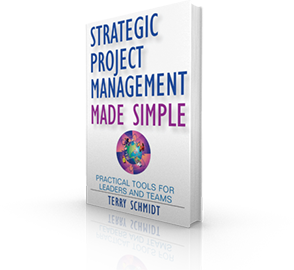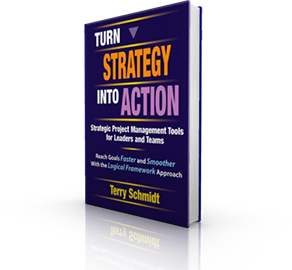By Terry Schmidt, Strategic Consultant and Founder
Imagine! You are standing barefoot at the edge of a forty-foot bed of hot coals at night. You feel their 1400 degree heat on your face and body as you ready yourself to walk across this bed of fire. As you look down at their menacing orange glow and prepare to take your first step, what thoughts might go through your mind? How would you mentally and physically prepare yourself to step out confidently and arrive undamaged on the other side?
I have barefoot firewalked eight times. Seven of those times, I made it safely with only a small blister on my big toe. But my first time was a bummer – I burned and blistered badly. From my firewalking adventures, I learned a principle that holds true in most tough work/life situations: Success depends on how well you keep your cool when the heat is on.
You might not walk barefoot across burning coals everyday, but we all face tricky situations where we aim to win but could get burned. Whether it’s making the perfect presentation to clinch the contract or sinking the last second jump-shot that wins the game, there are times when we need to be at our very best–despite the distractions, confusion, or unpredictability of the situation.
The ability to pull it off just about anything, anytime, anywhere requires being in the moment. This isn’t something you learn in an MBA program or can look up on the internet when you need to perform. Being in the moment means having immediate access to your own peak mental/emotional resource states. The ability to do so consistently is what distinguishes the outstanding professional from the merely competent one.
Being in the moment demands real-time, emotional management and self-determination. It’s the American Way writ large, the gritty determination of those running emergency rooms, jet fighters, task forces, laser labs and 5th-grade classrooms!
Recently, my good friend Dr. Hendrie Weisinger and I discussed how to create on demand that razor sharp, in-the-moment focus that is common to all high performers. Weisinger is a management consultant, psychologist and best-selling author well known for his work in emotional intelligence, anger management and peak performance. We exchanged stories from our own experience and offer these principles to anyone faced with a King Kong-scale issue.
1. Know Your Outcomes.
In any situation, you must know what you want to accomplish, produce, or achieve. Without a clear and strongly desired outcome, you can’t muster up your best resources.
In the work context, two types of outcomes usually operate simultaneously – the task/ organization outcome as well as your personal outcome. Let’s say you’ve been tapped to deliver an internal seminar on a topic you understand, but have never taught to your peers. The task outcome is to conduct a great seminar that people enjoy, learn from, and apply. But there are also personal outcomes in play, like demonstrating your expertise, gaining admiration of peers, and positioning yourself for greater responsibility. Being clear about your outcomes and their accompanying WIIFM’s (what’s in it for me) is what adds the emotional juice that greases the performance.
In his glory days, did you ever watch Michael Jordan call for the ball in the last few seconds of a tight game and toss the fade-away jumper that won the game? He didn’t have to think why. His ability to summon excellence in the moment was hard-wired and automatic because he practiced long hours to hone his skills before he walked into the game. Your own clutch performance skills can be practiced and available on-call.
Your practice routine consists of asking yourself often during the day –“What’s my outcome?” You’re in a meeting—“What’s my outcome?” You regroup after an interruption—“What’s my outcome?” You arrive home for the evening—“What’s my outcome?” (And yes, relaxing with family is a worthy outcome, but simply asking the question helps you do it better and enjoy it more).
Standing on the edge of fire, my task outcome was clear – walk the bed of coals and reach the other side without getting hurt. My personal outcome was to experience the exhilaration of doing something that seems impossible, then redirecting those triumphant feelings to energize other life areas I had procrastinated on – (Clean the garage? Finish my book? Win the Nobel?): As a bonus, firewalking offers an all-ears bar story.
2. Shut Out Distractions.
Ignore all irrelevant stimuli, external and internal. Weisinger calls this “strategic preoccupation,” which means the ability to blur out everything that won’t contribute to accomplishing the task at hand. Externally, this can be as simple as closing your door, turning off your cell phone and clearing your desk of other projects. Internally, it means removing the mental clutter and ignoring all but the salient issues. At this time, your mind frame is thatnothing else important exists. If today’s the day your kids are taking the SAT test that may shape their educational future, the heck with them – all you care about right now is your own particular test.
The one and only time I felt my feet fry while walking on fire was when a distraction crept in. Half way down the path, I heard a noise and glanced to the side, breaking my mental-emotional state. The sudden searing pain in my soles later became a blistery mess. The scar that remains today reminds me to shut out distractions when on task.
3. Structure Your Internal Dialogue.
Anticipate the success you want and choose carefully the optimum inner dialogue to support that outcome. The fact is that we all engage in self-talk nearly all the time. Sometimes it’s conscious, other times this monkey-mind chatter operates beneath our surface level of awareness. Are you aware of the internal conversation going on inside you right now? (At this very moment, the skeptics are saying to themselves, “no, I really don’t have these internal conversations”).
Premiere pro athletes prepare themselves for those inevitable clutch moments through intense visualization and affirmation. When the ninth inning relief pitcher steps in, his mind’s eye sees himself striking the batter out and saving the game. He is NOT thinking, “Well, I’ll go to the mound and see what happens….”
Recently I taught a Strategic Thinking & Planning certification workshop in San Diego with colleagues from the Haines Centre for Strategic Management. After three days of training, participants had to demonstrate their knowledge by making thirty minute presentations on various strategic concepts. An extremely bright woman in the program had practiced for her session the night before, but when she stepped to the stage, she got flustered, couldn’t find the right flip chart, and flummoxed herself. “I’m not prepared,” she said out loud. “I’m going to blow it.” Sure enough, she stumbled incoherently through and blew it.
Later I explained how her disempowering dialogue was a command to her brain to in fact “blow it”. The next day, before her second presentation, she relaxed and changed her self-talk by telling herself she would be great. Sure enough, she was.
If you underestimate the power your self-talk has over YOU, you reveal a deep misunderstanding which could be your Achilles tendon someday. Positive self-talk—particularly those consciously chosen instructions to self designed to reinforce your ability to deal with people, solve problems and reach positive outcomes—is a proven reality supporting most of the best minds in business, science, and government today!
In any tough situation, ask yourself, “What do I need to tell myself and to believe in order to pull this off?” That not only prepares your subconscious to support and strengthens you through positive self-talk prior to your situation, but also prepares the way for instructional self-statements to pop into consciousness during the experience!
How do you quiet your inner critic? Sometimes simply humming loudly to yourself blots out the random mind chatter, as does focusing on the in and out of your breathing. Over time, the twin disciplines of yoga and meditation condition you to naturally hush your constant babbling. . But you need to study and practice these skills (or any other) before you get into a situation where you’ll need to call on them.
Silly as it may seem, positive self-prompts like “Yes!”, “Just do it!”, “Go for it!”, and “I can do this!” create a self-fulfilling prophecy of success when shouted out loud with positive expectation.
4. Step into Optimum Physiology.
Elite performers in every field go through a ritual that readies them for peak performance. Watch track stars prepare for the hundred yard dash. They sprint 6-10 paces wearing their sweat suits, and then carefully position and pound in their starting blocks. After a few more 80% sprints, they shed their bulky sweats, adjust their sprint uniforms and their running spikes, and walk to their blocks. When they hear, “Runners, to your marks,” they settle themselves into their starting positions, breathe deeply, and clear their minds in anticipation of “Get set….” . When the pistol rings out, they burst into practiced and mastered states of optimum performance!
What inner focusing and energizing tips do you use? Make conscious note of them, and systematically apply them often to make physiology a stronger tool in your inventory of techniques. Whether you are aware or not, your own outstanding performances are supported by a personal physiology of excellence, a specific way of breathing, standing, moving, and a particular tempo in your mind and look on your face.
Identify ways to energize your environment as well as yourself. At this moment, I’m editing the final draft of this article at my stand-up desk—a trick old Ben Franklin used—while lively Mexican fiesta music plays in the background. Something about the-up tempo festiveness of mariachis keeps me productive, and standing keeps my mind alert, even as my hips sway to the lively trumpet notes.
Ever catch yourself in one of those “stuck states” where you are unfocused and unenergetic? When I find myself there, I break out by standing tall and assuming the physiology of confidence, and then asking myself, “What outcomes should I focus on right now?” This re-positioning in itself energizes me so much that I work at least 10% faster and better, whether it’s writing, organizing my project files, or replying to email.
When firewalking, the physiology of success means standing strong and tall, shoulders back, fists clenched, and repeating the mantra “cool moss, cool moss” to myself. This mentally coats my soles with asbestos and makes me feel unstoppable, impervious and smooth, ready to glide the over the flickering flames.
5. Stay in the Flow Zone.
These prior steps should put you in a state of relaxed concentration, able to handle issues in the moment with the confidence that comes from certainty about your outcomes.
The psychologist Mihalyi Czikszentmihalyi calls this flow— the best mind state from which to handle the inevitable bumps that come, the unexpected charge from the trenches, the klieg-lights of public performance. (See his book Flow: The Psychology of Optimal Experience).
Pro athletes don’t hear the screaming crowds or the heckling of the other team. They are so zoned in that it almost seems like slow-motion; the slow motion that Andre Agassi, all-time highest money-earning winner in professional tennis, described when asked about those 89 MPH balls being fired at him: “When I’m concentrating, I see everything from swing to connect. I know and start moving toward exactly the place I need to be as the ball comes gently toward me. I reach, extend my racket, and connect… usually!”
And the grin that flashed across his face let us know that even number-one-in-the-world-class winners neither hope nor expect to stop ALL the aces fired at them, but they develop the abilities to get enough to win more often than not.
Now I’ll share a few secrets for successful firewalking, if you promise not to try this at home. Firewalking is very much a stay in the moment exercise. You anchor yourself by loudly shouting, “YES!” and raising a fist to energize your system You look up and to the right, an eye position that puts your brain in a visual mode instead of kinesthetic, where you would be in touch with bodily sensations and feelings of heat. You repeat your mental mantra of “cool moss, cool moss” to quiet the mind chatter as you stride purposefully across, get to the end, and celebrate!
Here are a couple of preparation exercises to help you triumph when the heat is on:
(1) Think of those times in the past you’ve been absolutely at your best. Recall a specific experience when you were totally on. Notice the conditions that seem to be present when you are in peak state. How do you stand? What’s your pace and rhythm? What’s the tenor and key phrases of your self-talk? What’s the look on your face, from grim to determined grimace?
(2) Identify an upcoming situation where you’ll need to be on top of your game clearly identify your outcomes, personal and corporate. What’s the win in it for you? Visualize a successful outcome. If the context allows, rehearse it mentally in advance. Then, walk into the situation with the calm confidence that comes from already knowing the outcome and being present enough to perform at your very best
Do this consistently, and watch your effectiveness soar.
Contact Terry or call 206.433.0700 today for a confidential discussion of your issues and objectives.






